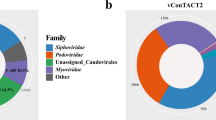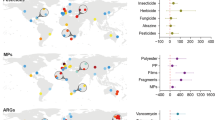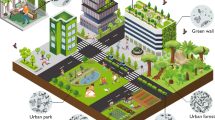Abstract
Animal pathogenic fungi, including human pathogenic fungi, cause millions of deaths annually. We know that these organisms can be found in our urban greenspaces where we enter in contact with them, yet the contribution of socioeconomic development in shaping the distribution of soil-borne animal pathogens from local to global scales remains virtually unknown. Here we used information from a global survey including 56 cities and a high-resolution local survey within Shanghai and found that socioeconomic factors were crucial in predicting the community composition and diversity of soil-borne pathogens. Our results were consistent after accounting for the effects of climate and soil properties. Trichosporon was identified as a universal indicator species for population density at both the global and local scales. Gross domestic product per capita and number of hospital beds were also critical predictors of a limited proportion of Trichosporon in Shanghai. Our study highlights the influence of human activities in shaping the pathogenic microbiome of cities with potential implications for human health, suggesting that poorer and more populated cities are expected to harbor larger proportions of soil-borne animal and human pathogens.
This is a preview of subscription content, access via your institution
Access options
Subscribe to this journal
Receive 12 digital issues and online access to articles
$119.00 per year
only $9.92 per issue
Buy this article
- Purchase on Springer Link
- Instant access to full article PDF
Prices may be subject to local taxes which are calculated during checkout





Similar content being viewed by others
Data availability
The data in this Article are publicly available on figshare33. Further details on the data can be obtained by emailing the corresponding author.
Code availability
The code that supports the findings of this study is available from the corresponding authors upon request.
References
Sun, S. et al. Fungal pathogens. Curr. Biol. 30, 1163–1169 (2020).
Brown, G. D. et al. Hidden killers: human fungal infections. Sci. Transl. Med. 4, 165rv13 (2012).
Fisher, M. C. et al. Emerging fungal threats to animal, plant and ecosystem health. Nature 484, 186–194 (2012).
Delgado-Baquerizo, M. et al. Global homogenization of the structure and function in the soil microbiome of urban greenspaces. Sci. Adv. 7, eabg5809 (2021).
Tosam, M. J. et al. Global emerging pathogens, poverty and vulnerability: an ethical analysis. Socio-cultural Dimensions of Emerging Infectious Diseases in Africa 20, 243–253 (2019).
Luck, G. W. A review of the relationships between human population density and biodiversity. Biol. Rev. 82, 607–645 (2007).
Alegbeleye, O. O. et al. Sources and contamination routes of microbial pathogens to fresh produce during field cultivation: a review. Food Microbiol. 73, 177–208 (2018).
Sun, X. et al. Harnessing soil biodiversity to promote human health in cities. Npj Urban Sustain. 3, 5 (2023).
Chagas, T. C. et al. Update on the genus Trichosporon. Mycopathologia 166, 121–132 (2008).
Archer-Dubon, C. et al. Superficial mycotic infections of the foot in a native pediatric population: a pathogenic role for Trichosporon cutaneum? Pediatr. Dermatol. 20, 299–302 (2010).
Padhye, A. A. et al. Trichosporon loubieri infection in a patient with adult polycystic kidney disease. J. Clin. Microbiol. 41, 479–482 (2003).
Walsh, T. J. et al. Infections due to emerging and uncommon medically important fungal pathogens. Clin. Microbiol. Infect. 10, 48–66 (2004).
Shigeko, K. et al. Invasive infection due to Trichosporon cutaneum in patients with hematologic malignancies. Cancer 82, 484–487 (1998).
Cáliz, J. et al. A long-term survey unveils strong seasonal patterns in the airborne microbiome coupled to general and regional atmospheric circulations. Proc. Natl Acad. Sci. USA 115, 12229–12234 (2018).
Barberán, A. et al. Continental-scale distributions of dust-associated bacteria and fungi. Proc. Natl Acad. Sci. USA 112, 5756–5761 (2015).
Di, Q. et al. Air pollution and mortality in the medicare population. N. Engl. J. Med. 377, 1498–1499 (2017).
Rentschler, J. & Leonova, N. Global air pollution exposure and poverty. Nat. Commun. 14, 4432 (2023).
Cheng, W. et al. Geographic distribution of heavy metals and identification of their sources in soils near large, open-pit coal mines using positive matrix factorization. J. Hazard. Mater. 387, 121666 (2020).
Kabala, C. et al. Conversion of soil pH 1:2.5 KCl and 1:2.5 H2O to 1:5 H2O: conclusions for soil management, environmental monitoring, and international soil databases. Pol. J. Environ. Stud. 25, 647–653 (2016).
Callahan, B. J. et al. DADA2: high-resolution sample inference from Illumina amplicon data. Nat. Methods 13, 581 (2016).
Nguyen, N. H. et al. FUNGuild: an open annotation tool for parsing fungal community datasets by ecological guild. Fungal Ecol. 20, 241–248 (2016).
Gardes, M. & Bruns, T. D. ITS primers with enhanced specificity for basidiomycetes—application to the identification of mycorrhizae and rusts. Mol. Ecol. 2, 113–118 (1993).
White, T. J. et al. Amplification and Direct Sequencing of Fungal Ribosomal RNA Genes for Phylogenetics. PCR Protocols: A Guide to Methods and Applications 315–322 (Academic Press, 1990).
Edgar, R. C. UPARSE: highly accurate OTU sequences from microbial amplicon reads. Nat. Methods 10, 996 (2013).
Wang, Q. et al. Naive Bayesian classifier for rapid assignment of rRNA sequences into the new bacterial taxonomy. Appl. Environ. Microbiol. 73, 5261–5267 (2007).
Oksanen, J. et al. Vegan: Community Ecology Package. R Package (The Comprehensive R Archive Network, 2019).
R Core Team. R: A Language and Environment for Statistical Computing (Version 3.6.3) (R Foundation for Statistical Computing, 2020).
Delgado-Baquerizo, M. et al. Microbial diversity drives multifunctionality in terrestrial ecosystems. Nat. Commun. 7, 10541 (2016).
Jing, X. et al. The links between ecosystem multifunctionality and above- and belowground biodiversity are mediated by climate. Nat. Commun. 6, 8159 (2015).
Caceres, M. D. et al. Indicspecies: relationship between species and groups of sites. R package (The Comprehensive R Archive Network, 2023).
Manzoni, S. et al. The global stoichiometry of litter nitrogen mineralization. Science 321, 684–686 (2008).
Muggeo, V. Segmented: an R package to fit regression models with broken-line relationships. R News 8, 20–25 (2008).
Luo, S. H. et al. Impact of socio-economic factors on soil-borne animal pathogenic fungi in urban greenspaces. figshare https://figshare.com/articles/dataset/URBAN_GLOBAL_LOCAL_dataset/24266059 (2023).
Acknowledgements
Y.F. acknowledges the financial support from National Natural Science Foundation of China (grant no. 42177297). J.H. acknowledges support from Shanghai Finance Special Project (Soil quality monitoring system for typical urban green spaces in Shanghai) and the Scientific Research Foundation of Shanghai Landscaping & City Appearance Administrative Bureau (G200201). M.D.-B. acknowledges support from TED2021-130908B-C41/AEI/10.13039/501100011033/Unión Europea NextGenerationEU/PRTR and from the Spanish Ministry of Science and Innovation for the I+D+i project PID2020-115813RA-I00 funded by MCIN/AEI/10.13039/501100011033.
Author information
Authors and Affiliations
Contributions
M.D.-B. and Y.F. developed the original idea and designed the research with discussion with R.C., J.H. and S.L. M.D.-B. and J.H. coordinated all field and laboratory operations. S.L., M.D.-B. and R.C. analyzed data. Field data were collected by M.D.-B., J.H., W.Z and R.C. The manuscript was written by S.L., R.C., J.H., M.D.-B. and Y.F., with contributions from all co-authors.
Corresponding authors
Ethics declarations
Competing interests
The authors declare no competing interests.
Peer review
Peer review information
Nature Cities thanks Shubo Fang, Ferry Hagen and the other, anonymous, reviewer(s) for their contribution to the peer review of this work.
Additional information
Publisher’s note Springer Nature remains neutral with regard to jurisdictional claims in published maps and institutional affiliations.
Supplementary information
Supplementary Information
Supplementary Figs. 1–4 and Table 1.
Rights and permissions
Springer Nature or its licensor (e.g. a society or other partner) holds exclusive rights to this article under a publishing agreement with the author(s) or other rightsholder(s); author self-archiving of the accepted manuscript version of this article is solely governed by the terms of such publishing agreement and applicable law.
About this article
Cite this article
Luo, S., Han, J., Chen, R. et al. Impact of socioeconomic factors on soil-borne animal pathogenic fungi in urban greenspaces. Nat Cities (2024). https://doi.org/10.1038/s44284-024-00073-1
Received:
Accepted:
Published:
DOI: https://doi.org/10.1038/s44284-024-00073-1



